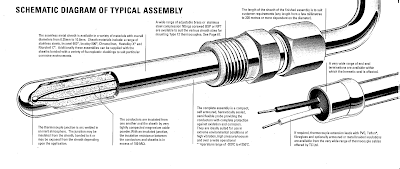Thermocouple Construction
In the case of mineral insulated couples and where beaded types are in pockets, the sheath material is chosen to give maximum protection over a long period. Since this varies with conditions e.g., sulphur laden atmosphere, fluctuating temperatures etc., it is important the correct materials are specified. Typical materials for mineral insulated couple sheaths are cupro-nickel, chromium - nickel - titanium and chromium - nickel - steel.
In 1821 the German physicist, Seebeck, observed the generation of an electromotive force in a closed circuit, containing two differing metals, when subjected to a temperature differential.
This effect now bears his name and is fact the principle of operation of a thermocouple.
The definition of the effect can be said to be:-
When two dissimilar metals or alloys are joined in a closed loop and one junction is heated, the e.m.f. developed is proportional to the difference in temperatures of the two junctions and to the types of materials used.

Figure 1
The basic explanation for this phenomenon is derived from the fact that when a metal is heated its molecules are agitated. At the same time the increased internal energy level allows the propagation and dispersal of free electrons within the metal. It is these electrons which make the metal a good electrical conductor.
Since different materials have different inherent energy levels for a given temperature, when two dissimilar metals are joined together an electron pressure differential is developed (See figure ). If the two junctions are subjected to a temperature gradient between them, the two differential electron pressures at the Hot Junction. and the Cold .Junction. show themselves as current flow within the closed circuit
The Peltier Effect
If a thermocouple, instead of being used as an e.m.f. source, is subjected to a DC. current the result is a cooling down of one junction and the heating of the other. If the current is reversed the cooling and heating effects appear at the opposite junctions. A device, consisting of a thermopile, employs this effect to achieve cooling in television cameras used in drum level monitoring where cooling by air draught is impossible.
The Thomson Effect
In any metallic conductor which is subjected to temperature gradients along its length and where DC. current is flowing, increases and decreases in ambient temperature occur within the conductor. This in turn may give rise to resistance changes sufficient to affect the accuracies of an instrument.
Different conductor materials are affected differently and to varying extents. Take for example two conductors, one of copper the other of iron.
Thermocouple Extension and Compensating Cables: CODES




Comments